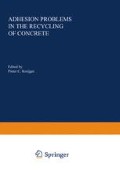Abstract
Demolition and fragmentation of concrete is currently being done using several techniques. Concrete has been fragmented using explosives, using hydraulic and pneumatic hammers, using a ball and a crane of using a hydraulic crane with ripping teeth and shovel. Depending on the method used in breaking concrete, concrete is subjected to different rates of straining and different modes of fracture. For the purpose of materials characterization, it may be convenient to differentiate various techniques of demolition according to the strain rate employed.
Access this chapter
Tax calculation will be finalised at checkout
Purchases are for personal use only
Preview
Unable to display preview. Download preview PDF.
References
H. A. Kormeling, A. J. Zielinski and H. W. Reinhardt, “Experiments on Concrete Under Single and Repeated Impact Loading,” Report 5–80–3, Stevin Laboratory, Delft University of Technology, Delft, The Netherlands.
D. E. Grady and M. E. Kipp, “Continuum Modeling of Explosive Fracture in Oil Shale,” Int. J. of Rock Mech., Minerals, Sci. § Geomech., Vol. 17, 147–157 (1980).
C. H. Heard, “Effect of Large Charges in Experimental Deformation of Yule Marble,” J. of Geol., Vol. 7, No. 2, 163.
D. L. Birkemer, “A Possible Fracture Criterion for Dynamic Tensile Strength of Rock,” Proc. of 12th Symp. on Rock Mech. (Edited by G. B. Clark), 573 (1971).
D. E. Grady and M. E. Kipp, “The Micromechanics of Impact Fracture of Rock,” Int. J. of Rock Mech., Minerals, Sci, and Geomech., Vol. 16, 293–302 (1979).
L. B. Freund, “Crack Propagation in an Elastic Solid Subjected to Stress Wave Loading,” J. of Mech., Phys. and Solids, Vol. 21, 47–61 (1973).
A. Kumar, “Effect of Stress Rate and Temperature on the Strength of Basalt and Granite,” Geophysics, Vol. 33, No. 3, 501–510 (June 1968).
V. K. Der, D. C. Holloway and T. Kobayashi, “Techniques for Dynamic Fracture Toughness Measurements,” Report, Mechanical Engineering Department, University of Maryland, College Park, Maryland (1980).
J. W. Dally and W. L. Fourney, “Fracture Control in Construction Blasting,” University of Maryland Report to NSF (1976).
M. Wecharatana and S. P. Shah, “Double Torsion Tests for Studying Slow Crack Growth of Portland Cement Mortar,” Cement and Concrete Research, Vol. 10, 833–844 (1980).
G. Velazco, K. Visalvanich and S. P. Shah, “Fracture Behavior and Analysis of Fiber Reinforced Concrete Beams,” Cement and Concrete Research, Vol. 10, 41–51 (1980).
K. Visalvanich and S. P. Shah, “Evaluation of Fracture Techniques in Cementitious Composites,” Proc. on Fracture in Concrete, ASCE Annual Convention, Florida (October 1980).
M. Wecharatana and S. P. Shah, “Resistance to Crack Growth in Portland Cement Composites,” Proc. on Fracture in Concrete, ASCE Annual Convention, Florida (October 1980).
S. P. Shah, “Whither Fracture Mechanics in Concrete Design,” Proc. of the Engineering Foundation Conference on Concrete Production and Use, New Hampshire, 175–185 (June 1979).
K. Visalvanich and A. E. Naaman, “Compliance Measured Fracture Toughness of Mortar and Fiber Reinforced Concrete,” to be published in the Proc. of the ASTM Conf. on Fracture Mechanics Methods for Ceramics, Rocks and Concrete, Chicago (June 1980).
W. Suaris, U. Gokoz, O. Youngquist and S.,P.Shah, “Analysis of Inertial Effects in the Instrumented Impact Testing of Fiber Reinforced Concrete,” Progress Report, U. S. Army Research Office (1980).
U. N. Gokoz and A. E. Naaman, “Effect of Strain-Rate on the Pull-Out Behavior of Fibers in Mortar,” Progress Report, submitted to U. S. Army Research Office (Jan. 1981).
Author information
Authors and Affiliations
Editor information
Editors and Affiliations
Rights and permissions
Copyright information
© 1981 Plenum Press, New York
About this chapter
Cite this chapter
Shah, S.P. (1981). Materials Characterization for Fragmentation. In: Kreijger, P.C. (eds) Adhesion Problems in the Recycling of Concrete. Nato Conference Series, vol 4. Springer, Boston, MA. https://doi.org/10.1007/978-1-4615-8312-7_23
Download citation
DOI: https://doi.org/10.1007/978-1-4615-8312-7_23
Publisher Name: Springer, Boston, MA
Print ISBN: 978-1-4615-8314-1
Online ISBN: 978-1-4615-8312-7
eBook Packages: Springer Book Archive

